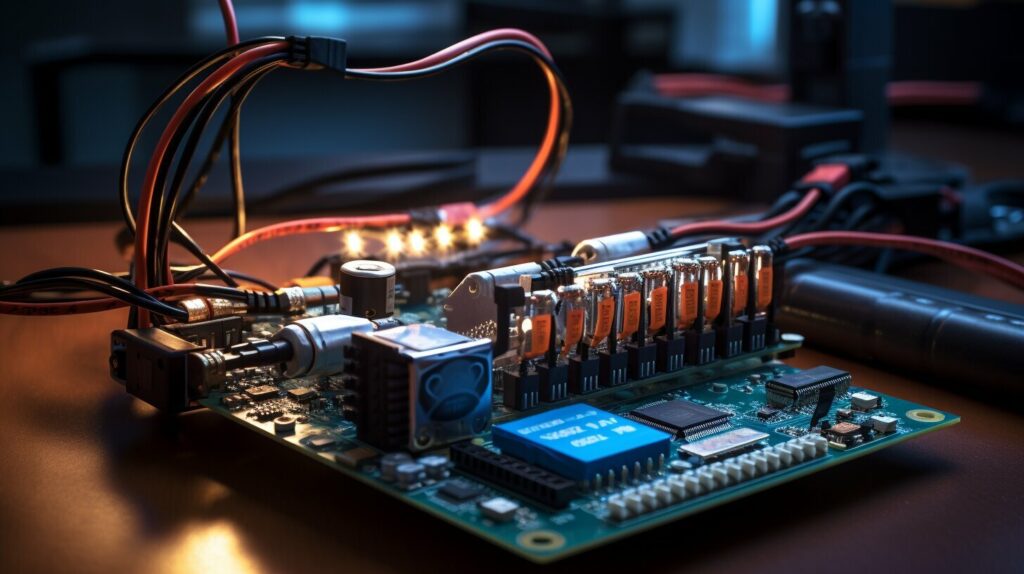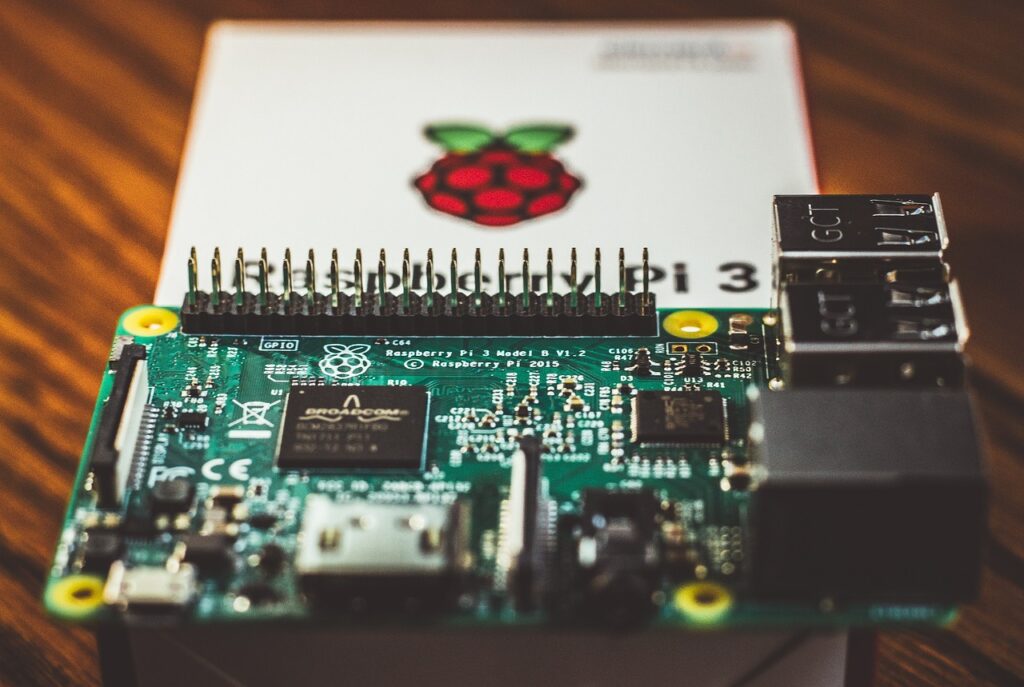When it comes to choosing between Arduino UNO and Raspberry Pi, understanding their capabilities is crucial in the British tech community. These two platforms, although different, offer unique features that cater to specific project needs. In this comparative guide, we aim to provide you with valuable insights to help you make an informed decision.
Arduino Compatible Boards are microcontroller-based board that is ideal for quick programming and circuit prototyping. With its ease of use and vast compatibility, it allows you to control motors, LEDs, and interface various sensors, making it a go-to choice for makers and hobbyists.
On the other hand, Raspberry Pi serves as a microprocessor-based board and acts as a valuable learning tool for computer programming. Its robust capabilities enable it to tackle more complex tasks such as running elaborate robots and monitoring the weather. It provides a platform for those looking to dive deeper into the world of programming.
Key Takeaways:
- Arduino UNO is simple, easy to use, and affordable. Suitable for quick programming and circuit prototyping.
- Raspberry Pi is a powerful, built-in WiFi, HDMI, and Costly to start learning
- The major differences between the two boards are CPU power, power requirements, GPIO functionality, and cost.
Arduino UNO: The Compelling Simplicity
If you’re a beginner looking to dip your toes into the vast ocean of DIY, Arduino UNO might just be the perfect companion for you. This microcontroller board is known for its simplicity and ease of use.
Here is Arduino Compatible Board offered by Kunkune.

One of the key benefits of Arduino UNO is its versatility in quick programming. The board is equipped with a powerful microcontroller that can be easily programmed using the Arduino IDE, a free software development environment. This means that you can write your code, upload it to the board, and see the results in a matter of minutes. Arduino UNO also supports a wide range of libraries and shields, allowing for seamless integration with various components and sensors.
Additionally, Arduino UNO is an excellent choice for circuit prototyping. The board features multiple digital and analog input/output pins, enabling you to connect and control various electronic components. Whether you want to control motors, LEDs, or interface with sensors, Arduino UNO provides a convenient platform to build and test your circuits. It also supports breadboard-friendly headers, making it easy to connect and disconnect components without the need for soldering.
Table 1: Comparison of Arduino UNO and Raspberry Pi
| Features | Arduino UNO | Raspberry Pi |
|---|---|---|
| Operating System | Arduino IDE | Yes |
| CPU Power | Limited | High |
| Power Requirements | Low | High |
| GPIO Functionality | Extensive | Limited |
| Cost | Affordable | Higher |
The choice between the two ultimately depends on your specific project needs. If you require quick programming and circuit prototyping, Arduino UNO would be an ideal choice. However, if you need a board with an operating system, higher CPU power, and more advanced functionalities, Raspberry Pi might be the better option.

In conclusion, Arduino UNO is a microcontroller-based board that provides an efficient and user-friendly platform for quick programming and circuit prototyping. Its versatility, ease of use, and extensive community support make it a popular choice among electronics enthusiasts. By understanding the differences between Arduino UNO and Raspberry Pi, you can make an informed decision and choose the right board for your specific project needs.
Raspberry Pi: The Mighty Mini-Computer
If you’re yearning for more power and versatility in your DIY projects, then Raspberry Pi might be the answer to your call. Contrary to Arduino UNO’s microcontroller nature, Raspberry Pi is a credit card-sized single-board computer. With a wide range of programming languages and development environments supported, Raspberry Pi offers endless possibilities for creative projects and practical applications. Whether you want to build a mini-computer, develop home automation systems, or explore robotics, Raspberry Pi provides a platform that encourages experimentation and hands-on learning.

One of the key advantages of Raspberry Pi is its ability to run a full-fledged operating system like Linux, expanding its capabilities beyond basic microcontrollers. This allows users to develop complex software applications and interface with various peripherals using the board’s GPIO (General Purpose Input Output) pins. From controlling LEDs and motors to collecting data from sensors, Raspberry Pi offers an extensive range of opportunities to develop coding skills while working on real-world projects.
With its robust processing power and vast memory options, the Raspberry Pi is well-suited for multimedia applications and media centers. You can transform it into a capable media streamer or even set up your own home theater system. Its HDMI output and support for popular media software like Kodi and Plex make it a favorite choice for entertainment enthusiasts.
Looking to dive into the exciting world of Internet of Things (IoT)? Raspberry Pi has got you covered. Its built-in Wi-Fi and Ethernet connectivity, paired with its GPIO (General-purpose input/output) pins, enables seamless integration with various IoT devices. You can develop smart home systems, weather stations, or even create your own small-scale IoT networks.
When it comes to complex data processing and analytics, Raspberry Pi once again proves its mettle. With its superior processing capabilities and the ability to install and run software like Python, R, or even Apache Spark, you can crunch numbers like a pro. Whether you’re analyzing big data sets or training machine learning models, Raspberry Pi provides the horsepower you need.
Comparing Arduino UNO and Raspberry Pi
Now that we’ve explored the strengths of each platform, let’s dive deeper into a comparison, ensuring you pick the perfect fit for your DIY project.
CPU Power:
Arduino UNO is equipped with an 8-bit microcontroller that operates at a lower clock speed, making it suitable for simple tasks that require precise timing. In contrast, Raspberry Pi features a much more powerful 64-bit microprocessor, enabling it to handle more complex computations and run resource-intensive applications.
Power Consumption and Form Factor:
Arduino UNO consumes significantly less power compared to Raspberry Pi, making it ideal for battery-powered projects or projects where power efficiency is essential. Additionally, Arduino UNO’s small form factor allows for compact designs and easy integration into smaller enclosures. Raspberry Pi, with its larger size and higher power consumption, might require more planning for power supply and physical accommodation.
| Arduino UNO | Raspberry Pi |
|---|---|
| Relatively low power consumption | Requires higher power due to its more powerful processor |
Hardware Capabilities and Limitations:
Arduino UNO is tailored for simple projects that don’t demand excessive processing power or memory. On the other hand, Raspberry Pi offers vast hardware capabilities and can handle more complex tasks with ease. If your project requires real-time functionality, Arduino UNO’s deterministic behavior might be preferable, whereas Raspberry Pi shines in tasks requiring extensive computational power.
Programming Flexibility:
Arduino UNO uses Arduino programming language, which is based on C/C++. It offers a simpler syntax and is ideal for beginners. Raspberry Pi, on the other hand, allows you to use a wide range of programming languages, including Python, Java, and even more advanced options like MATLAB. If you’re looking to expand your knowledge of different programming languages, Raspberry Pi provides a more flexible playground.
Cost Considerations:
When it comes to cost, Arduino UNO is generally more affordable compared to Raspberry Pi. The simplicity of Arduino UNO’s design and functionality contributes to its lower price, making it a popular choice for beginners and hobbyists.
In summary, Arduino UNO and Raspberry Pi serve different purposes and cater to distinct project requirements. Arduino UNO is ideal for quick prototyping and simple control tasks, while Raspberry Pi offers more advanced capabilities for computer programming and complex projects. Understanding the major differences between these two boards will help you make an informed decision based on the specific needs of your project.
Community Support and Learning Resources:
Both Arduino UNO and Raspberry Pi have strong and vibrant communities, providing ample support and learning resources online. Arduino’s community is known for being beginner-friendly, with lots of tutorials and forums. Raspberry Pi’s community is more diverse, catering to both beginners and advanced users alike. No matter which platform you choose, finding answers to your questions and getting help will be a breeze.
Choosing the Right Board for Your Project
Now that you understand the strengths and differences between Arduino UNO and Raspberry Pi, let’s lay out a roadmap to help you make the right decision.
Identify Your Project Requirements and Goals: Clearly define what you aim to achieve with your DIY project. Consider factors such as complexity, real-time requirements, and the need for extensive data processing or connectivity.
Consider Your Technical Skills and Familiarity: Assess your programming and electronics skills. If you’re a beginner, Arduino UNO’s simplicity might be a better starting point. If you have experience with programming or desire to explore different languages, Raspberry Pi provides a more versatile platform.
Evaluate Budget Constraints and Scalability Potential: Determine your budget availability and consider the scalability potential of your project. Arduino UNO’s initial lower cost might favor small-scale or budget projects, while Raspberry Pi’s additional features and computationally intensive capabilities may be more suitable for expansive and feature-rich designs.
Review Project Complexity and Additional Components: Analyze the complexity of your project and whether you require extensive hardware capabilities, real-time functionality, or additional sensors and peripherals. This assessment will guide you in choosing the most appropriate platform.
Seek Advice from Online Communities and Forums: Don’t underestimate the power of community support. Engage with Arduino or Raspberry Pi communities, participate in forums, and seek advice from experienced DIY enthusiasts. Their insights and experiences will further assist you in making an informed decision.
Comparison of Arduino UNO and Raspberry Pi
Remember, the success of your project ultimately hinges on selecting the right tool for the job. Whether it’s Arduino UNO or Raspberry Pi, both boards offer incredible potential for innovation and creativity. Now armed with the knowledge of their strengths and differences, you can confidently embark on your project and bring your ideas to life.

Arduino UNO offers a vast array of projects and tutorials that facilitate hands-on learning and the implementation of various applications. Whether you are a beginner looking to explore the world of electronics or an experienced enthusiast seeking to enhance your skills, Arduino UNO provides endless possibilities.
One popular project for Arduino UNO is creating a temperature and humidity sensor. With the help of a few components, including a DHT11 sensor and an LCD display, you can build a device that accurately measures and displays temperature and humidity levels. This project is great for understanding sensor interfacing and data manipulation.
Another exciting application is building a line follower robot. By connecting motors, infrared sensors, and an Arduino UNO board, you can construct a robot that follows a predetermined path. This project is ideal for those interested in robotics and automation, allowing you to learn about motor control and sensor integration.
To take your Arduino UNO skills further, there are numerous online tutorials available. These tutorials cover a wide range of topics, such as LED control, servo motor programming, and wireless communication. They provide step-by-step instructions, circuit diagrams, and code examples to guide you through each project, ensuring a smooth learning experience.
Endless possibilities that await you!

To begin your journey with Arduino UNO, it’s essential to grasp the basics of programming and understand the software tools available for development. Arduino UNO uses a simplified programming language that is easy to learn and work with, making it an ideal choice for beginners and experienced developers alike.
The Arduino Integrated Development Environment (IDE) is a user-friendly software that provides the necessary tools for writing and uploading code to the Arduino UNO board. It includes a code editor with syntax highlighting, a serial monitor for debugging, and a library manager for accessing pre-built code examples and additional functionalities.
With the Arduino IDE, you can write programs, known as sketches, in C/C++ language. These sketches are then compiled into machine-readable code and uploaded to the Arduino UNO board via a USB connection. The IDE also offers a wide range of built-in libraries that simplify complex tasks, such as controlling motors, interacting with sensors, or communicating with other devices.

- User-friendly interface: The IDE provides a simple and intuitive interface, making it accessible to users of all skill levels.
- Code examples: The built-in library manager offers a vast collection of code examples that can be used as a starting point for your projects.
- Serial monitor: This tool allows you to monitor the communication between your Arduino UNO board and your computer, enabling you to debug and troubleshoot your code.
- Version control: The IDE supports version control, allowing you to track changes in your code and easily revert to a previous version if necessary.
By familiarizing yourself with the Arduino UNO programming language and the software tools provided by the Arduino IDE, you’ll be well-equipped to start exploring the endless possibilities of the Arduino UNO board.
| Arduino UNO | Raspberry Pi |
|---|---|
| Microcontroller-based board | Microprocessor-based board |
| Suitable for quick programming and circuit prototyping | Functions as a learning tool for computer programming |
| Used for controlling motors, LEDs, and interfacing sensors | Capable of running elaborate robots and complex tasks |
| Does not have an operating system | Has an operating system |
| Lower CPU power | Higher CPU power |
| Lower power requirements | Higher power requirements |
| Offers limited GPIO functionality | Provides extensive GPIO functionality |
| Cost-effective | Relatively more expensive |
FAQ
Q: What are the major differences between Arduino UNO and Raspberry Pi?
A: The major differences include the presence of an operating system, CPU power, power requirements, GPIO functionality, and cost.
Q: How do I choose the right board for my project?
A: The choice between Arduino UNO and Raspberry Pi depends on your specific project needs. Consider the capabilities and features of each board and match them to your project requirements.
Q: Are there any projects and tutorials available for Arduino UNO?
A: Yes, there are numerous projects and tutorials available for Arduino UNO that can help you explore its practical applications and enhance your knowledge.
Q: How do I get started with Arduino UNO?
A: To get started with Arduino UNO, you will need to familiarize yourself with programming and software aspects specific to Arduino. There are resources and guides available to help you with this process.
Q: What should I know about Arduino UNO’s hardware?
A: Understanding Arduino UNO’s hardware is essential for utilizing its functionalities effectively. This includes knowing about pins, datasheets, and schematics, which provide insights into how the board operates.
